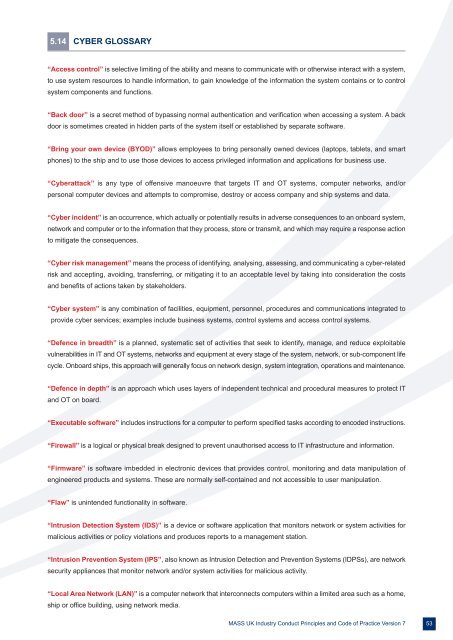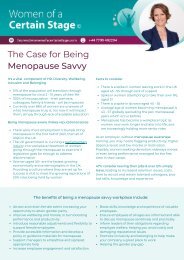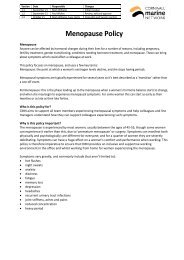COP_2023_V7_pages
Create successful ePaper yourself
Turn your PDF publications into a flip-book with our unique Google optimized e-Paper software.
5.14 CYBER GLOSSARY<br />
“Access control” is selective limiting of the ability and means to communicate with or otherwise interact with a system,<br />
to use system resources to handle information, to gain knowledge of the information the system contains or to control<br />
system components and functions.<br />
“Back door” is a secret method of bypassing normal authentication and verification when accessing a system. A back<br />
door is sometimes created in hidden parts of the system itself or established by separate software.<br />
“Bring your own device (BYOD)” allows employees to bring personally owned devices (laptops, tablets, and smart<br />
phones) to the ship and to use those devices to access privileged information and applications for business use.<br />
“Cyberattack” is any type of offensive manoeuvre that targets IT and OT systems, computer networks, and/or<br />
personal computer devices and attempts to compromise, destroy or access company and ship systems and data.<br />
“Cyber incident” is an occurrence, which actually or potentially results in adverse consequences to an onboard system,<br />
network and computer or to the information that they process, store or transmit, and which may require a response action<br />
to mitigate the consequences.<br />
“Cyber risk management” means the process of identifying, analysing, assessing, and communicating a cyber-related<br />
risk and accepting, avoiding, transferring, or mitigating it to an acceptable level by taking into consideration the costs<br />
and benefits of actions taken by stakeholders.<br />
“Cyber system” is any combination of facilities, equipment, personnel, procedures and communications integrated to<br />
provide cyber services; examples include business systems, control systems and access control systems.<br />
“Defence in breadth” is a planned, systematic set of activities that seek to identify, manage, and reduce exploitable<br />
vulnerabilities in IT and OT systems, networks and equipment at every stage of the system, network, or sub-component life<br />
cycle. Onboard ships, this approach will generally focus on network design, system integration, operations and maintenance.<br />
“Defence in depth” is an approach which uses layers of independent technical and procedural measures to protect IT<br />
and OT on board.<br />
“Executable software” includes instructions for a computer to perform specified tasks according to encoded instructions.<br />
“Firewall” is a logical or physical break designed to prevent unauthorised access to IT infrastructure and information.<br />
“Firmware” is software imbedded in electronic devices that provides control, monitoring and data manipulation of<br />
engineered products and systems. These are normally self-contained and not accessible to user manipulation.<br />
“Flaw” is unintended functionality in software.<br />
“Intrusion Detection System (IDS)” is a device or software application that monitors network or system activities for<br />
malicious activities or policy violations and produces reports to a management station.<br />
“Intrusion Prevention System (IPS”, also known as Intrusion Detection and Prevention Systems (IDPSs), are network<br />
security appliances that monitor network and/or system activities for malicious activity.<br />
“Local Area Network (LAN)” is a computer network that interconnects computers within a limited area such as a home,<br />
ship or office building, using network media.<br />
MASS UK Industry Conduct Principles and Code of Practice Version 7<br />
53

















